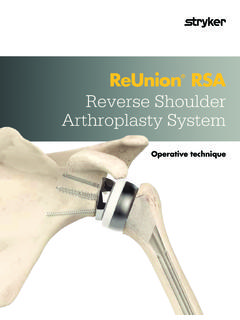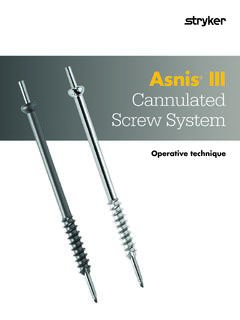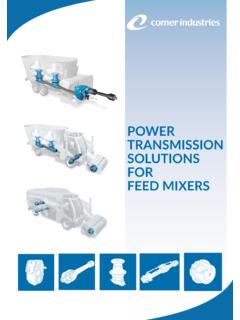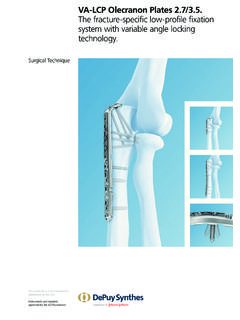Transcription of VariAx 2 Mini Fragment System
1 Operative techniqueVariA x 2 Mini Fragment System2 VariAx 2 Mini Fragment SystemContentsIndications, precautions, contraindications and MRI safety information ..3 System overview ..4 Reduction instruments ..4 Plate positioning ..5 Plate contouring and cutting ..6 Instrumentation ..8 Modular self-ratcheting and fixed handles ..8 Depth measuring options ..9 Taps and countersink ..9 Drill bits and guides ..10K-wire drill bits ..11 VariAx2 screw platform ..12 Color coding ..12 SmartLock technology ..13 Locking and non-locking screws ..13 Washers ..13 VariAx 2 Mini Fragment plates ..14 Plate platform ..15 Plate platform - compression options ..16 Operative technique ..17 Plate fixation ..17 Compression technique hybrid LC hole (Uni-directional) ..20 Compression technique compression hole (bi-directional) ..22 Lag screw technique ..24 This publication sets forth detailed recommended procedures for using Stryker devices and instruments . It offers guidance that you should heed, but, as with any such technical guide, each surgeon must consider the particular needs of each patient and make appropriate adjustments when and as workshop training is recommended prior to performing your first surgery.
2 Please remember that the compatibility of different product systems has not been tested unless specified otherwise in the product labeling. Consult Instructions for Use ( ) for a complete list of potential adverse effects, contraindications, warnings and precautions. Follow the instructions provided in our cleaning and sterilization guide (OT-RG-1). All non-sterile devices must be cleaned and sterilized before instruments must be disassembled for cleaning. Please refer to the corresponding assembly / disassembly instructions. The surgeon must warn patients of surgical risks, and make them aware of possible adverse effects. The patient should be warned that the device cannot and does not replicate a normal healthy bone, that the device can break or become damaged as a result of strenuous activity or trauma, malunion or nonunion. The surgeon must warn the patient that the device has a finite expected service life and may need to be removed at some time in the the event of contamination, or expiration of shelf life or in the case of products supplied non-sterile, the product must be subjected to an appropriate cleaning process and sterilized by means of a validated sterilization procedure before use, unless specified otherwise in the product labeling or respective product technical VariAx 2 Mini- Fragment System is indicated for fracture fixation, reconstruction, replantation, stabilization, reduction, fusions, osteotomies, mal-unions, and non-unions of small bones and small bone fragments including normal and osteopenic bones in adult and adolescent (12 21 years) patients.
3 The System is also indicated for non-load bearing stabilization and reduction of bone fragments in long with other systemsComponents from this System may be used with the following systems: VariAx 2 SystemPrecautionsSee package insert for warnings, precautions, adverse effects and other essential product physician s education, training and professional judgement must be relied upon to choose the most appropriate device and treatment. Conditions presenting an increased risk of failure include: Any active or suspected latent infection or marked local inflammation in or about the affected area. Compromised vascularity that would inhibit adequate blood supply to the fracture or the operative site. Bone stock compromised by disease, infection or prior implantation that cannot provide adequate support and/or fixation of the devices. Material sensitivity, documented or suspected. Obesity, unless used with a compatible System that may also be used in obese patients.
4 An overweight or obese patient can produce loads on the implant that can lead to failure of the fixation of the device or to failure of the device itself. Patients having inadequate tissue coverage over the operative site. Implant utilization that would interfere with anatomical structures or physiological performance. Any mental or neuromuscular disorder which would create an unacceptable risk of fixation failure or complications in postoperative care. Other medical or surgical conditions which would preclude the potential benefit of surgery. MRI safety informationNon-clinical testing has demonstrated the VariAx 2 Mini Fragment System is MR Conditional. A patient with this device can be safely scanned in an MR System meeting the following conditions: Static magnetic field of T or T Maximum spatial field gradient of 3000 gauss/cm (30 T/m) Maximum MR System reported, whole body averaged specific absorption rate (SAR) of 2 W/kg (Normal Operating Mode) Scan time restriction: maximum 6 minutes of continuous scanningUnder the scan conditions defined above, the VariAx 2 Mini Fragment System is expected to produce a maximum temperature rise of less than C after 6 minutes of continuous non-clinical testing, the image artifact caused by the device extends approximately 28 mm from the VariAx 2 Mini Fragment System when imaged with a gradient echo pulse sequence and a T MRI and contraindicationsThe MRI safety information provided is based on testing which did not include supplementary devices.
5 If there are supplementary devices ( plates, screws, wires, etc.) present in proximity to the VariAx 2 Mini Fragment System , this could result in additional MRI effects and the information provided above may not overviewInstrumentationSharp Hook (700151)Hohmann Retractor 6mm (700664)Ball Spike (700153)Hohmann Retractor 15mm (700667)Termite forceps (705151)Straight Reduction Clamp (703822)Straight Reduction Clamp, Broad (705297)Repositioning forceps (702932)Reduction instruments and retractorsThese tools facilitate fracture reduction and soft tissue aid in plate positioning, the joystick for T8 holes (703927) can be used in any circular hole in the and/or plates and the joystick for T6 holes (705140) can be used in any circular hole in the plates. Additionally, they can also be used to temporarily fix the plate to the bone by inserting a K-wire with a diameter up to through a joystick that is already engaged in the plate inserting the joystick tip in the circular hole, turn the knob on the upper part of the joystick clockwise to fix it in the hole.
6 To remove the joystick, simply remove any K-wire and turn the knob counter-clockwise to disengage the tip from the hole. System overviewPlate positioning Do not insert a K-wire through a joystick on the compression side of the fracture if compression is needed. Do not use the engaged joystick to apply bending to the plate as this may damage the plate or contouring of all plates is possible using the Plate Bender (705143). The multiple-use plate bender can be used for both in-plane and out-of-plane bending for all plate sizes. Both sides of the bender have a laser etching identifying which plate size may be contoured on that respective side. Bending options are shown in the figures on the right. The stop line laser engraved on the plate bender indicates the maximum allowable in-plane bend for the broad locking plates. In-plane bending of the broad locking plates should not be performed past this stop of all profile and narrow locking plates as well as broad locking plates is possible using the plate cutter (702951).
7 And broad locking plates come in increments of 2 holes. System overviewPlate contouring and cuttingOut of plane bendingIn-plane bendingStop markings7In addition, contouring of narrow locking and profile plates as well as the broad locking plates is also possible using the Plate Bending Pliers (45-80010) when required based on local patient factors or anatomy. Furthermore, the plates can be twisted by using a Plate bending plier (45-80010) in combination with the Plate Bender (705143).In order to reduce the likelihood of a stress riser effect and avoid reducing the fatigue properties of the implant in load bearing situations and for treating comminuted fractures, care should be taken to only moderately bend the plate in between overviewPlate contouring Only moderate bending is recommended. Excessive plate bending may lead to failure of the plate or the locking mechanism and should be avoided. Do not re-bend plates or bend plates at a screw hole.
8 The plate bending pliers are designed to be used only in circular holes. If the oblong compression holes are deformed, there may be potential for a screw to pass through the hole upon insertion. Always attach the bending pliers to two adjacent holes to prevent deformation of the screw Coupling insert(703923)Ratcheting insert(703922)Elastosil handle, cannulated, AO coupling(45-90200) System overviewInstrumentationModular self-ratcheting and fixed handlesThe VariAx 2 System offers modular handle options. Medium Handles can be interchanged with either a bi-directional ratcheting AO-coupling insert (703922) or an optional standard fixed AO-coupling insert (703923).The ratcheting insert can work in three modes: clockwise ratcheting, counter-clockwise ratcheting or neutral. To switch between the different modes, simply twist the distal part of the insert to the desired driving medium sized handle is equipped with a spin-cap to allow insertion using a two-finger technique.
9 In order to disengage the insert from the handle, push down on the button on the distal part of the handle and pull the insert away from the handle. A small elastosil handle is also handle (703921) The insert must be removed from the handle before limit torque transmission of screws, use the small elastosil ensure appropriate ratcheting function, perform appropriate maintenance on the insert by applying medical-grade lubricant oil through the marked overviewInstrumentationDepth measuring optionsDrills and K-wire Drills are scaled to allow for estimated correct screw length when used with the dedicated drill , a standard Depth Gauge (705141) can be used either independently or through a plate and countersinkA countersink (706200) is available for reducing the screw head prominence when the screw is used independently of a plate. It can be used for all screw types of this screws are self-tapping. Taps are available in (706201), (703900) and (703899).
10 Drill bit (705134) for and screwsTapDrill bit (705133) for screwsCountersink (706200) for screwsDepth Gauge (705141)If excessive resistance is felt during insertion or if the bone is dense it is recommended to use a Guide for screws, compression and polyaxialDrill Guide for / screws, compression and polyaxialDrill guide for independent lag screwDrill guide for independent lag screwDrill guide for independent lag screwSystem overviewInstrumentationScrew color codingScrew diametersDrill guidesInterfaceDrill bits diameterOverdrill for screw bit, scaledDrill bit, overdrillDrill bits and guidesThe drill guides facilitate drilling of pilot hole for either a non-locking or locking screw. Furthermore, the opposite side of the guide facilitates fixed angle drilling for use in a compression hole when compression is standard drill bits allow for drilling a pilot hole until 30mm for screws and 40mm or 70mm for and screws. Overdrills and drill guides for interfragmentary lagging technique are available for all screw match the color ring marking on the drill bit with the color marking on the drill guide.











